As part of my research into DNA connections to early settlers of North America I noticed a number of DNA links to individuals with the Brown, Brun (including LeBrun) and Braun family names in their tree. Getting large numbers of matches to Brown was not surprising considering that it is one of the most common surnames in English-speaking countries. It is the second most common surname in Canada and Scotland, third most common in Australia and United Kingdom and fourth most common in England and the United States. The Brown surname is particularly clustered in southern Scotland. Brun is a relatively uncommon name in the English-speaking world (see https://forebears.io/surnames/brun ) but is the 8th most common surname in France. The Braun surname is most common in Germany where it is the 12th most common surname but only the 876th most common surname in the USA. Within Germany the Braun surname is most common in the Baden-Württemberg region. The following map shows the Geographic distribution of different spellings of the Brown surname in Germany.
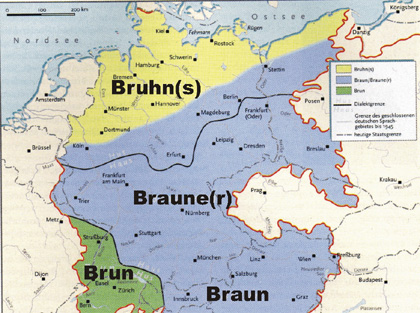
The Brun surname is most common in France with the highest frequency (1 in 558) in the Auvergne-Rhône-Alpes region. Guernsey, Channel Islands (pop. 91K) has an higher frequency of the Brun surname than France but lower than the Auvergne-Rhône-Alpes region of France.
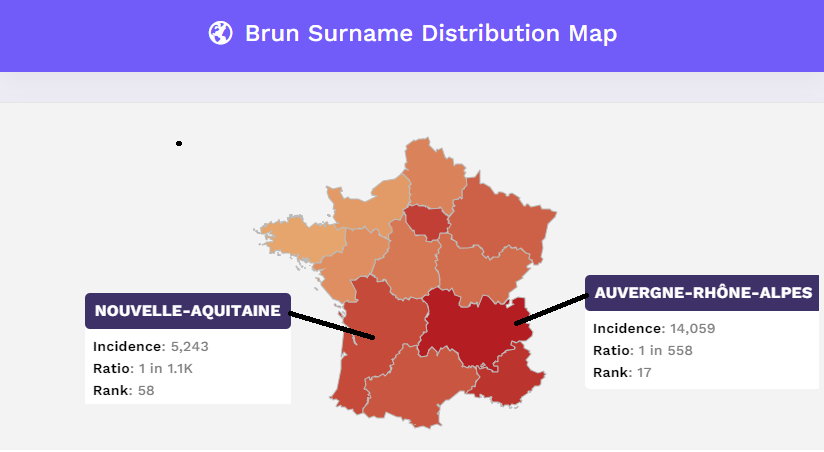
The clusters of the Brun surname in France (the Auvergne-Rhône-Alpes region) and the Braun surname in Germany (the Baden-Württemberg region) are separated by less than 300 km at their closest points (see Map below).
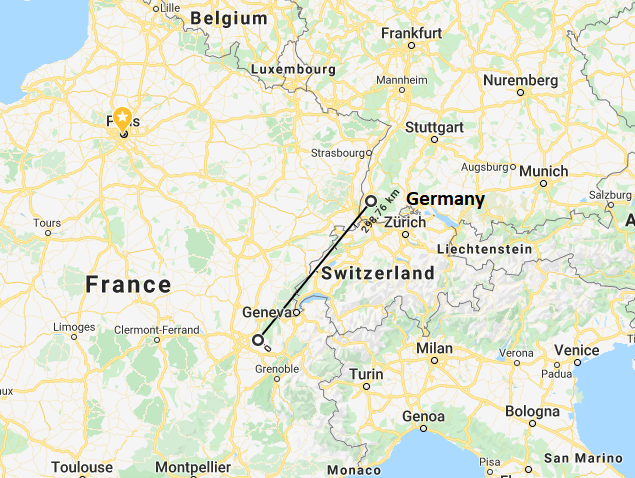
Switzerland has a relatively low frequency of both names. Within France the Bourgogne–Franche–Comté region separates these two areas and within this region the Brun surname ranks 117th. and the Braun name is relatively uncommon. The eastern part of this region, historically Franche-Comté, was only ceded to France in the 1678 and even after this enclaves such as Montbéliard remained outside French control until 1793. Many French Protestants fled this area during the 18th century.
I had 36 matches to Braun and 35 to Brun (all out to 8 cM) and my sister got similar numbers (39 and 49). My two 3rd cousins with common Newell ancestor also had a significant number of matches to both names. I also had 18 matches to Lebrun and my sister and cousins also had roughly similar numbers. I also had 54 matches to Braun and 19 matches to Brun in the 6-8 cM range (these matches were separated out since starting in August 2020 Ancestry will not provide matches for this range) .
To explore the differences between the links to Brun (including LeBrun) and Braun I mapped the geographic location of the earliest ancestor of DNA matches to my sister and I . The Brun, Lebrun and Le Brun matches are shown by the red symbols and the Braun matches are shown by blue symbols. In some locations there are clusters of matches in one location (e.g. Brun around Loudun, France). Approximately, half of the markers indicate matches to both my sister and I withe the others being for just one of us.
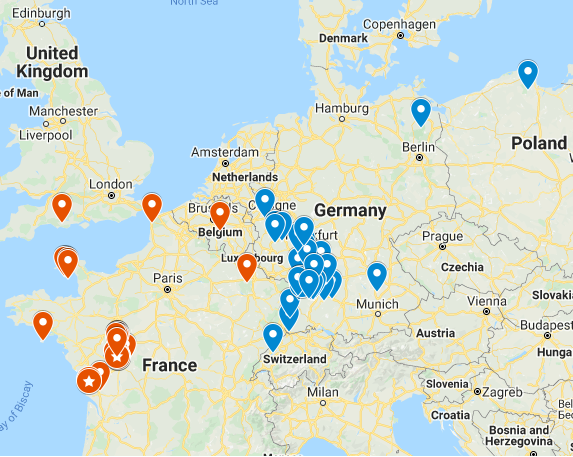
Brun & Lebrun in red Braun in blue.
The 44 Braun matches are mainly in Germany and are spread out in an arc along the western border of Germany with a cluster centered around Stuttgart, Germany. There are some Braun outliers in Poland and in Russia (not shown); many of these were Mennonites who migrated to these areas from Germany. The absence of Braun matches in Eastern France may be a result of Protestants and Ethnic Germans from these areas moving to Germany or being killed during the French Wars of Religion (17th and 18th Centuries). This topic will be discussed later in this paper.
The 53 Brun, Le Brun and Lebrun matches are clustered (60%) in the Poitou–Charentes region of France and are linked to a few Brun families (possibly all related) from the area around Loudun and La Chaussee (60 km & 40 km north of Poitiers) who departed France for Acadia (now Nova Scotia, Canada) in the early 1600s. Poitou is believed to be the region of origin of most of the Acadian and Cajun populations of North America. There is a second smaller cluster for people with the Brun, Le Brun and Lebrun names who were living in Jersey, Channel Islands in the 1700s (no clear links to Acadia). The matches for my cousins with Dock Newell Ancestry follow a similar pattern.
Brun, Le Brun, Lebrun
In Poitou–Charentes the Brun name is linked to the Angevin Kings of England (Henry II, Richard I and John). through the Lords of Lusignan who were frequently referred to as Le Brun (see below).

Isabella of Angoulême the widow of King John returned to her native France and married Hugh X de Lusignan (AKA Hugues X le Brun) on 10 May 1220. Many children from this marriage became English Earls (see tree below).
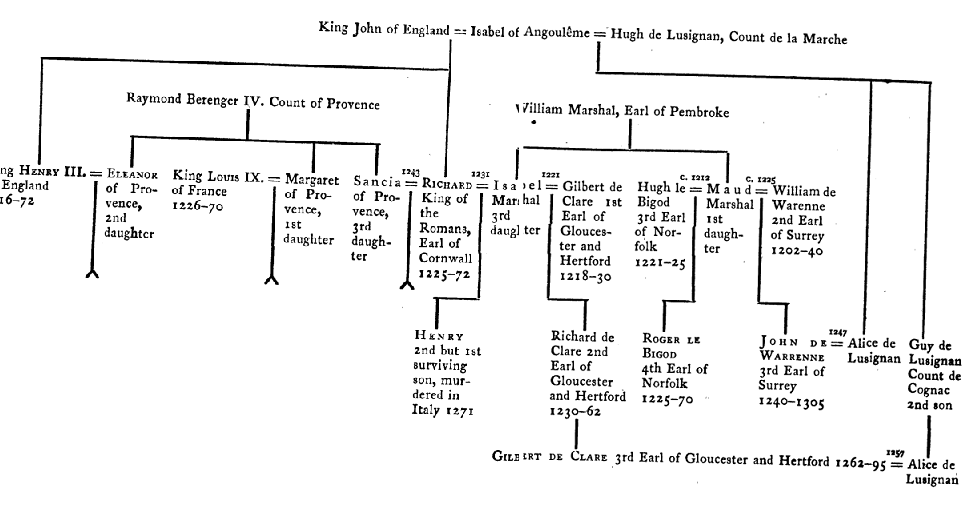
Guy, the last male in the French branch of the House of Lusignan died childless in 1308 and subsequently his sister Yolande sold the fiefs of Lusignan, La Marche and Fougères to Philip IV of France. A junior line under William de Valence (born Guillaume de Lusignan) became important in English politics due to his relationship to King Henry III of England. He was heavily involved in the Second Barons’ War, supporting the King and Prince Edward against the rebels led by Simon de Montfort. The French conquest of Poitou in 1246 created great difficulties for William’s family, and so he and his brothers, Guy de Lusignan and Aymer, accepted Henry III’s invitation to come to England in 1247.
Lusignan (25 km southwest of Poitiers) is less than 70 km south of Loudun and Châtellerault ( a Lusignan holding) is less than 40 km away. While there is no direct connection between people with the Brun name and the House of Lusignan a connection is not out of the question.
The Le Brun name also occurs in England and Scotland in the 12th and 13th century. Sir Hugh le Brun was one of the Lords of the Marches of Wales. His grandson, Sir William landed in Ireland in 1172 during the Norman invasion, and his son, Fromond le Brun, was Chancellor of Ireland in 1230. Sir Richard Le Brun (AKA Broun, Bruyn, Brown) was living in Cumberland, England in the 13th century. The surname is first recorded in Scotland when Sir David Le Brun, in 1128, witnessed the foundation charter of Holyrood Abbey in Edinburgh. Between 1194 and 1214 Patric Brun witnessed resignation of land at Warmanbie in Annandale. Several Brun’s of Edinburgh and Berwick are recorded as signing the Ragman Roll of 1296 when the Scottish nobility were forced to swear allegiance to King Edward I. These individuals likely had their origins in France and followed the Normans to England and may or may not be linked to the House of Lusignan.
The Scottish Clan Broun [Brown] is of interest based on their origins and apparent connections to the Yules of Scotland (see my section Ancestry DNA Results Part II, The Old World). The Brouns of Colstoun (two miles south of Haddington, East Lothian) enjoyed considerable royal favor, which may have been because of their claimed descent from the royal house of France. The chief’s arms even bear the three gold lilies of France. This Clan claim descent from Sir David le Brun who was one of the witnesses, with King David I of Scotland, in laying the foundation of Holyrood Abbey on 13 May 1128.
First reference to the Yule family of Scotland was in 1430 at Garlton, or Garmilton, Haddingtonshire (two miles north of Haddington) . In 1561 Alexander Yule of Garmilton, sheriff depute of Haddington, on the mains of the lands RE Garleton Castle: Athelstaneford, East Lothian.
A cadet branch of Clan Broun, the Brouns of Sauchie, also have a connection to the Yules. William Broun (styled son and heir of William Broun of Sauchie) gives an obligation to James Shaw in 1480. In 1500 he is designed of Sauchie when acting as bailie for William Broun of Colstoun,
his son ? In 1536 this last Alexander (Broun) is succeeded by his son, who sold Sauchie to his cousin, James Shaw. In my Section on the Yule family in Ancestry DNA Results Part II I identified a link between the Yules of Haddington and the Shaws of Sauchie who have “three cups” in their arms.
Sir Richard Le Brun of Cumberland, England in the 13th century (see earlier reference) was likely a Scottish Broun since Richard de Broun, keeper of the king’s peace in Cumberland, was forfeited in the Black Parliament (held at Scone, Scotland) in 1320.